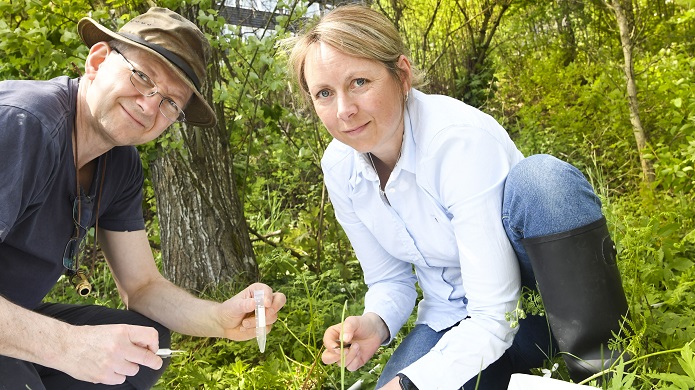Five fascinating facts about ticks
Sunshine, summer, holidays – and ticks. Just like wasps, ticks are the sand in the ice-cream cone of summer – but there are ways of avoiding bringing them home and being infected by tick-borne diseases.

Patrik Dinnétz, senior lecturer in biology, and Thérese Janzén, doctoral student in environmental science, are studying ticks and tick-borne diseases. Thérese’s thesis is part of a research project at Södertörn University that focuses on ticks in urban green areas. Its purpose is to study where ticks thrive and where they don’t, and how you can avoid being infected by tick-borne diseases.
“Ticks are rewarding to work with,” says Patrik. “They are easy to catch and study. They also cause problems for humans and many people have strong feelings about them, but not positive ones.”
Thérese has a personal reason for choosing to study this unpopular little organism:
“When I was young we had a holiday home in the Stockholm archipelago, where there were so many ticks! People close to me have suffered from both Lyme disease and TBE [tick borne encephalitis]. My dissertation for my Master’s in Infectious Disease Control at Södertörn University was about the risk of equine anaplasmosis – Anaplasma is a bacterium that is spread by ticks and which can also infect humans. After that, I realised I wanted to continue by researching and working on diseases that are transferred by ticks. I wanted to discover more about the environments in which the risk of being infected by tick-borne disease is greatest and perhaps help others not to be affected by diseases like TBE,” she says.
Patrik and Thérese bring out a white sheet, test tube, a mop and some rubber gloves – we’re going on a tick hunt! While we’re on our excursion they share their expertise on the pest we hope not to see this summer – and tell me five fascinating facts:
- The three life stages of a tick
The tick is an arachnid that lives for four to five years. It has three life stages; larva, nymph and adult tick. They live a quiet life, sitting on a blade of grass waiting for a host animal to pass by and let it have one of the two or three meals of blood in its life. A tick only needs to eat once at each stage of life; the male only eats twice, once as a larva and once as a nymph. The female also eats as an adult, so she has enough energy to produce around 2000 eggs. A bonus fact is that tick larvae only have six legs and then, like all arachnids, they grow eight legs. - Any animal can be a host animal
Ticks have almost no preferences when it comes to their host animals, so they just attach themselves to whatever happens to pass by: birds, humans, foxes, deer, cats or dogs – even amphibians and snakes. Ticks can also travel on migrating birds, so new types can appear in a country, for example the Hyalomma “giant tick”, which was found in Sweden in unusually large numbers last year. It was once unable to survive here, but now appears to have taken up residence in parts of southern Sweden. - Ticks don’t just suck blood
We often say that ticks suck blood, but this doesn’t work in the same way as for a mosquito. Once a tick has attached to a host animal, it injects it with saliva. This contains enzymes that break down the cells beneath the skin, as well as an anticoagulant, so the blood flow does not clot. Then the tick starts to eat from the cell soup that has formed around its mouthparts. Often, many ticks gather close together and share this cell soup with each other, so bacteria and viruses are able to spread between the ticks. - How diseases are transferred
Ticks can carry around twenty different diseases. In Sweden we mostly talk about TBE and Lyme disease. TBE is transferred by the saliva injected by the tick. Unfortunately, if we are bitten by one of the few ticks with TBE we are infected almost immediately. On the other hand, Lyme disease is transferred when the tick has eaten and then regurgitates, which is a nicer way of saying that it pukes undigestible leftovers back into the host animal. The bacteria found in the tick’s stomach are carried along, infecting the host animal. This may occur after about 24 hours, so if you find and remove the tick quickly there is only a small risk of catching Lyme disease. - How to avoid ticks and their diseases
Ticks attach most easily to things that are a soft and fluffy. Hairy legs and brushed cotton are perfect for ticks! Slippery fabrics and rubber boots provide good protection, and mosquito repellent has also been proven to be somewhat protective. Some people are clearly less attractive to ticks than others – but we still don’t know why. If you are bitten by a tick, pull it off as soon as possible with tweezers. Take hold of the tick and pull it straight out. It is a good idea to apply antiseptic afterwards. Keep an eye on it and contact the health services if you see a large red ring growing around the bite. In Sweden, you can call Vårdguiden 1177 External link, opens in new window. for advice about tick bites (link in Swedish).
External link, opens in new window. for advice about tick bites (link in Swedish).
Page updated
04-06-2019






